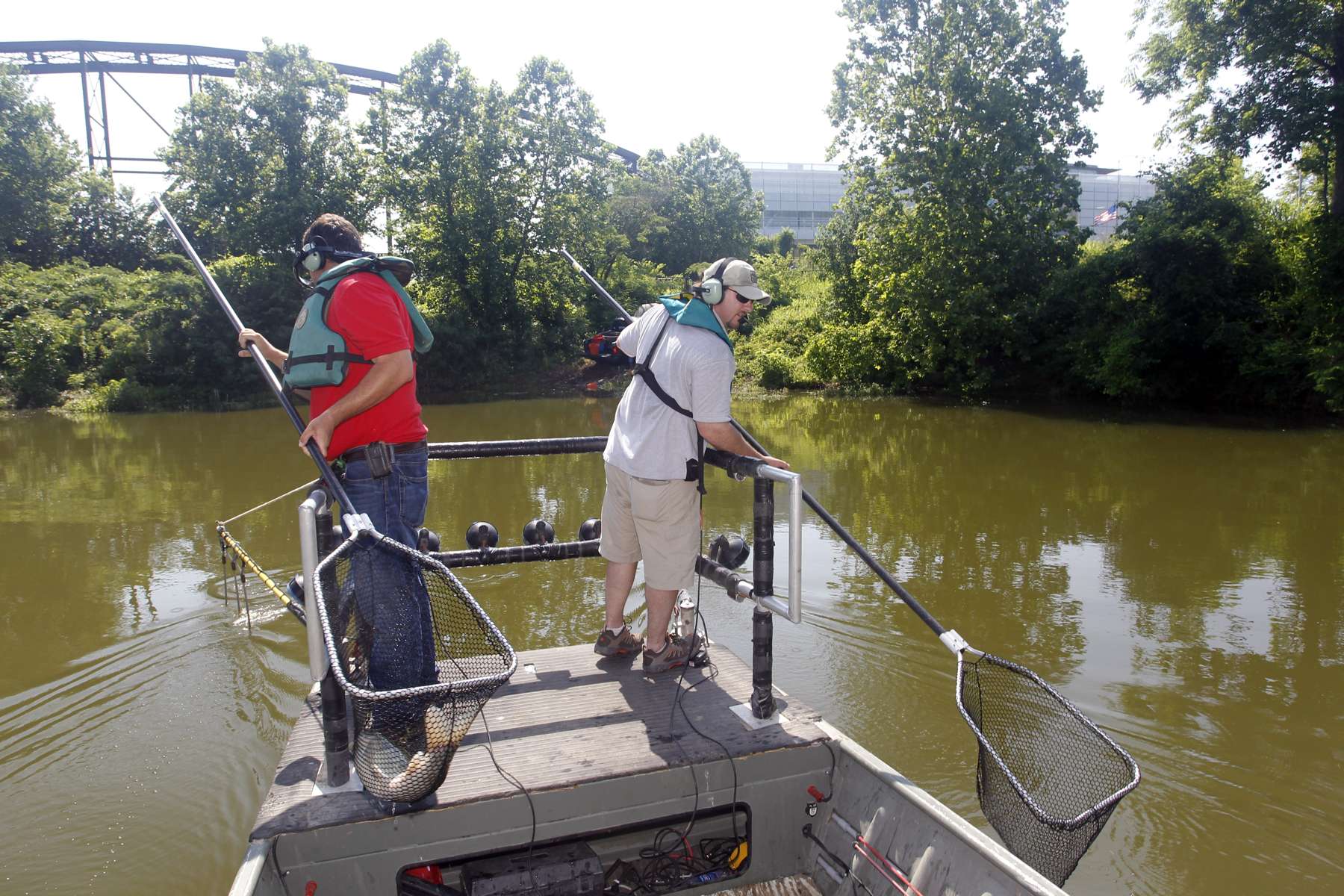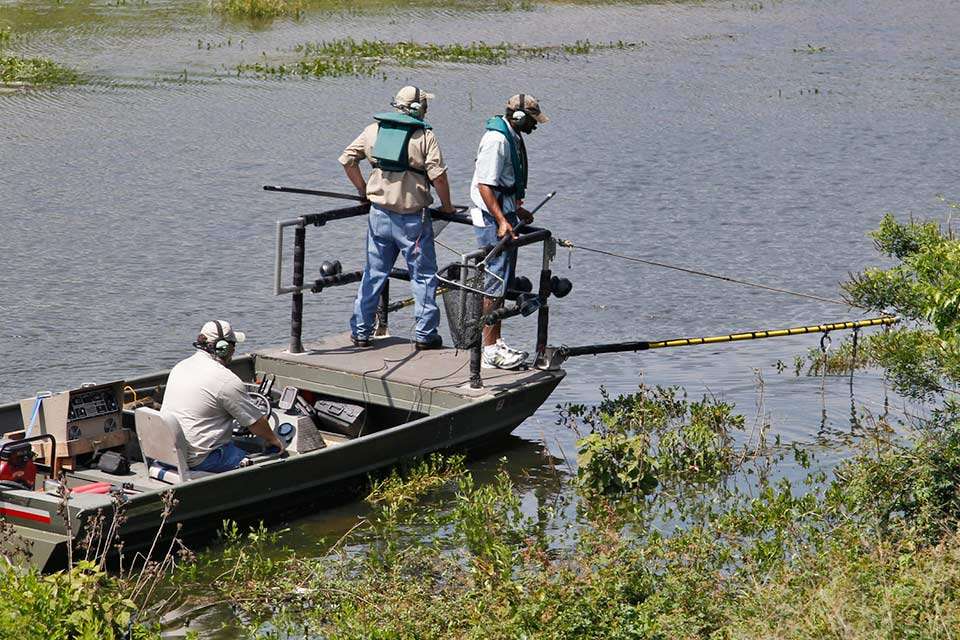
MOUNTAIN HOME, Ark. — On a sunny afternoon, Jeremy Risley was waiting to put tournament anglers’ fish in his tank to release back in Bull Shoals Lake.
Before the top 12 teams of Carhartt College Series weighed in, the Daily Limit picked the brain of the regional fisheries biologist of the Arkansas Game and Fish Commission (AGFC). His bottom line was that tournaments are beneficial to his work, which is to make sure the fishery is healthy.
“We appreciate when any tournament circuit comes here,” Risley said. “We’re a small, rural area, so any influx of money and tax dollars we can get goes a long way. It comes back here.
“We definitely couldn’t do what we do as fishery managers without having anglers, including tournament anglers.”
Bassmaster college, high school and junior events brought almost 600 anglers to Bull Shoals and Norfork lakes in late April. Each had to purchase licenses and many picked up tackle, gear and other equipment during their visit. License fees and tackle taxes are used for local fisheries management.
“Much of that work is making sure the fish populations are healthy,” said Risley, adding that the AGFC’s main tool is electrofishing studies. “We monitor the lake. We use this data to evaluate how the population looks, like do we need to change regulations? Our electrofishing pretty much drives our bass management.”
The AGFC randomly selects areas in each section of the lake for its spring surveys. A device mounted on the front of a boat momentarily shocks the fish so they rise to the surface, where biologists scoop them up with nets. On the boat, the fish are measured and released, and that data is recorded. At each predetermined area, the team works about a quarter mile of shoreline, from 15 to 20 feet out and to 10 feet deep.
“So we sample and we derive a metric called Catch Per Unit Effort,” he said. “We may sample 100 fish in 10 minutes, and we calculate how many fish that is per hour.”
That data, which is a miniscule portion of the biomass in the fishery, isn’t used to extrapolate the total number of sportfish in a body of water, Risley said. It simply helps them determine the health of the fishery and to set daily and length limits. And electrofishing brings up a massively higher percentage of fish than anglers, who would be fortunate to hook several fish from a similarly-sized area.
“On Norfork, we can average up to 300 fish per hour,” he said. “We’ve had up to 1,000 fish per hour sample run. That’s more than our dippers can dip. We’re dipping four or five at a time, and we’re missing fish. Each year is different.”
Risley said one of the big difference-makers in an infertile lake like Bull Shoals is having fluctuating water levels. The biologists see larger populations after high-water years. On Bull Shoals, the water can rise 40 feet, creating a “new-lake affect.”
“It does three main things: the fry has protection to hide; the predator and prey fish have protection; it also increases the fertility of the lake. That introduction of terrestrial soil — the decomposition of leaves, etc. — releases nutrients. We need this high water to increase fertility.”
After high waters, Risley said the lakes he manages have experienced population spikes, where 20 to 30 times as many fish have survived spawns.
“This year is great,” Risley said. “The college and high school anglers are just catching tons of fish right now. It’s because of high water we had in 2013 and 2015. These lakes do awesome after high waters.
“It’s not from us stocking fish like some people think. In fact, we haven’t stocked a bass in Bull Shoals since the 1960s. This is totally a water level deal. So when we have the high water, we have good fishing a couple of years later, and when we go for long periods without the high water, numbers of bass in the lake decrease. And in a lake the size of Bull Shoals, we couldn’t stock enough fish to make up for 1 percent of that difference.”

Surveys conducted after bass tournaments show “no difference” in their study samples.
“There have been enough studies in literature” to show that, he said. “The only time there could be an impact is in a summer tournament.”
While a small percentage of bass do die in tournaments, he said that has little to no effect on the fishery. While numbers vary from lake to lake, Risley said about one quarter of the fish population dies each year of various causes.
“If you look across the southeast United States, it’s 25 to 30 percent every year — diseases, old age, they get eaten,” he said. “We’re talking about all fish, from the little guys to the big ones.
“Then we get a percentage that die postpawn just from the stresses of spawning, them not eating. Usually those are some of the older fish, and they’re just stressed out. That’s when you see your higher percentages.”
Scheduling events outside the range of the spawn would prove difficult, he said, because of all the variables involved like when the actual spawn occurs on any given body of water and its longevity.
While there still are some recreational anglers who keep and eat bass, harvest continues to decrease. Risley said the greatest crisis to bass fishing are kills, which mostly come with low oxygen.
“We see that from time to time around the state. These are bigger lakes here, don’t have the high nutrients, so we don’t see that oxygen depletion,” Risley said. “When that starts breaking down, that bacteria takes up all the oxygen. That’s what you’ll see on very fertile bodies of water.”
All told, recreational fishing in the lakes Risley covers keeps him working, and in turn, he helps anglers keep catching fish.
“We have a big walleye angling population here. We have a walleye club that’s very active. On Norfork, we have a bunch of striped bass anglers and people come in for them,” he said, noting the region has world class trophy trout in both lakes’ tailwaters. “We appreciate all anglers, including tournament anglers. We appreciate what they do for the state of Arkansas.”





